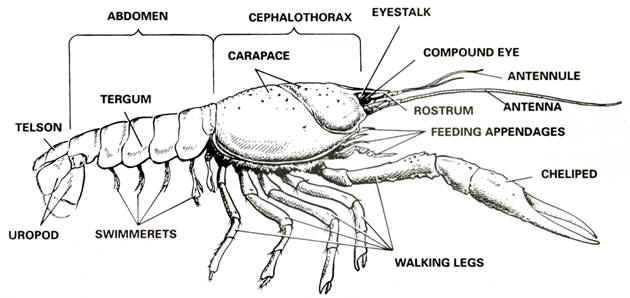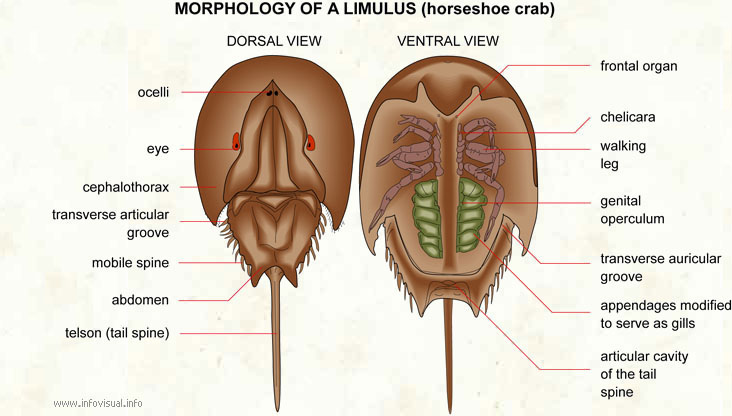Annelids and Arthropods:
Major characteristics of annelids:- All annelids are bilaterally symmetrical meaning that if you split the organism in half into left and right sides, they would be the same.
- Most have a coelom, a fluid filled cavity between the wall of their body and their gut. It is used as storage for their gametes and also used for locomotion.
- An external cuticle that they do not shed that covers their body for protection.
- Many also have parapodia, which are unjointed segments that extend from the body wall, but not all annelids have this.
- A nervous system comprising of a brain, sessile annelids have simpler brains whereas those that are mobile brains are more complex.
- Sense organs: six different sensory structures can be found: palms, antennae, eyes, statocysts, nuchal organs, and lateral organs.
- Segmental organs, which are actually kinds of ducts that are required for the transferring of the gametes when they are mature.
 |
| Photo of multiple Nereis worms in formaldehyde. |
 |
| Annelid setae at 4x/0.10 magnification. |
The parapodia is the unjoined limbs that you can see extending off of the sides that the Nereis worm uses for locomotion.
 |
| Image of an errant polychaete taken by me. |
Differences between Errant and Sedentary polychaetes:
Errant polychaete have a large number of body segments. They have few anterior appendages that are differentiated into palms, antenna, and tentacular cirri. They are active swimmers or crawlers, free to go where they want. Since they can move, they are scavengers or predators on plants and animals which they are able to feed on because they all have jaws.
Sedentary polychaetes have a limited number of body segments, they may be more typically separated into different regions. They also usually do not have anterior appendages or will only have a few. Sedentary polychaetes are burrowers or tube dwellers so they do not need these other appendages. They feed instead by filter or deposit feeding and consuming the sediments.
Major characteristics of Arthropods:
- Arthropods are invertebrates but, to make up for this they produce a hard exoskeleton made out of chitin that protects their bodies. As they grow, they molt or shed their old skeleton to grow a new larger one.
- Bilaterally symmetrical protostome, meaning the body can be divided vertically and both sides will be exactly the same.
- Bodies are internally and externally segmented.
- All arthropods have jointed limbs attached to their exoskeletons which allows for both flexibility and movement.
- Open circulatory system instead of a closed circulatory system. Their blood is pumped through sinuses to get to the tissues.
 |
| Preserved crayfish specimen. |
Crayfish have a good example to use to show the characteristics of arthropods. They have a hard exoskeleton that it divided into two main parts, the cephalothorax and the abdomen. The cephalothorax contains the head and thoracic region and is covered by the carapace, part of the exoskeleton. It consists of 13 divided segments and the abdomen is made out of 6, each segment contains a pair of appendages. The head has 5 alone, the antennules which are organs for balance, touch, taste, and smell. The chelipeds are the claws that they use for defense and to catch its prey and swimmerets are used to create water currents and function in reproduction.
 |
| Labeled crayfish anatomy from Biology Junction. |
Similarities and differences in body shape and form between crabs and crayfish:
- Crabs and crayfish are both Arthropods so they share the five major characteristics with one another. Crabs have wide flat bodies with no obvious tails, instead it is tucked underneath its body, whereas crayfish have distinct tail like feature. Crabs head and chest are combined together instead of being two different regions. Crabs also do not have distinct antenna.
Horseshoe crab's bodies are separated into three different sections, the prosoma containing the cephalothorax, the opisthosoma with the abdomen, and the telson section which is the tail. It uses its first pair of underside appendages, the chelicera to place food into its mouth. Horseshoe carbs have gills to bring in water and filter it out to obtain the oxygen to respirate. It differs from true crabs because of its tail which it uses to steer while swimming and can also use to flip itself over if it gets stuck on its back.
- Crabs and crayfish are both Arthropods so they share the five major characteristics with one another. Crabs have wide flat bodies with no obvious tails, instead it is tucked underneath its body, whereas crayfish have distinct tail like feature. Crabs head and chest are combined together instead of being two different regions. Crabs also do not have distinct antenna.
| Two crabs dried crab exoskeletons. |
 |
| Labeled image of a horseshoe crab. From www.infovisual.info. |
- Barnacles feed through cirri, which are feather-like appendages. They can extend and retract quickly through the opening at the top of the barnacle bringing in microscopic organisms. Barnacles are surrounded by an outer chitin shell which is open or closed depending on the tide levels. Youtube link of live barnacles feeding: https://www.youtube.com/watch?v=lAU0FUxBSmU
 |
| Chitin shells of dead barnacles. |


Comments
Post a Comment